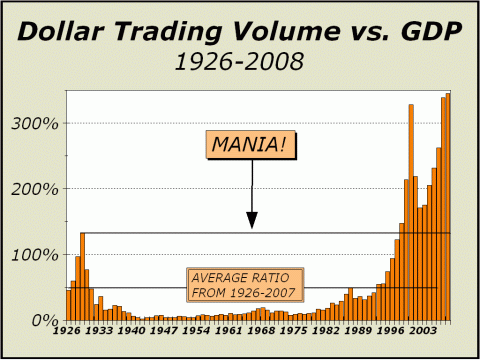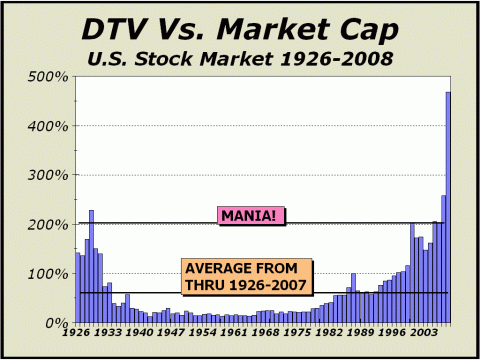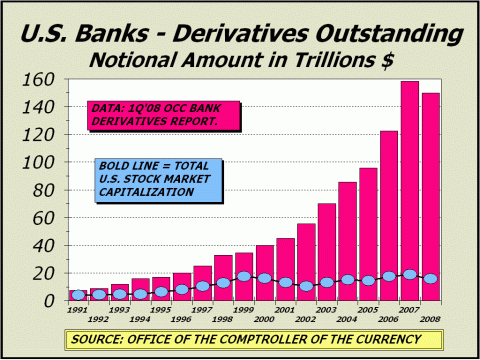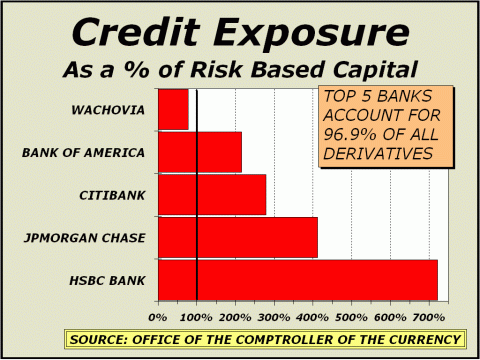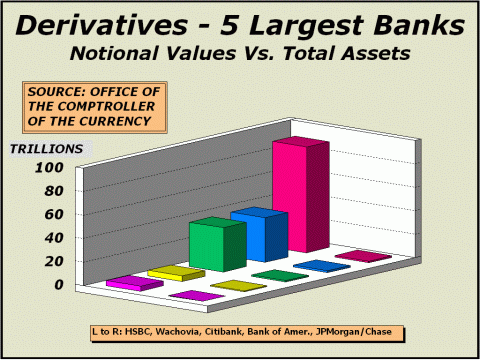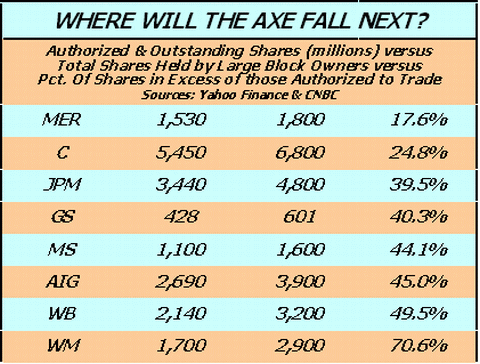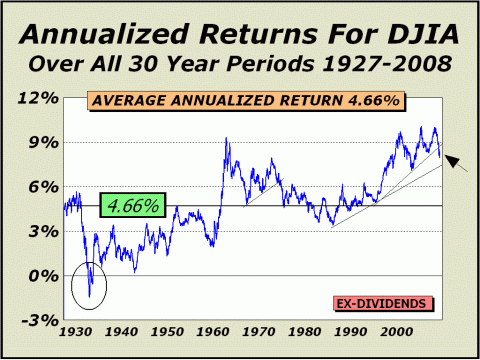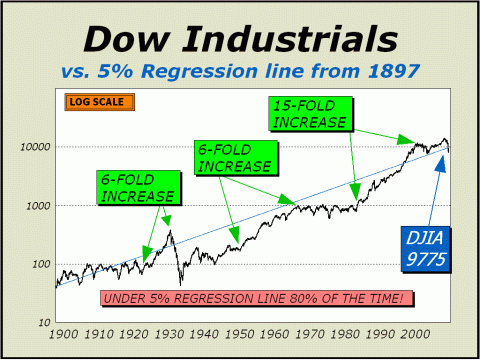
|
- THE GREATEST STOCK MARKET MANIA
OF ALL TIME -
DATED DECEMBER 9, 2008 A SPECIAL REPORT BY ALAN M. NEWMAN, EDITOR CROSSCURRENTS |
|
Our readership
continues to grow, even through the bear market.
This report is now mostly a compilation of articles that have previously appeared in the Crosscurrents newsletter. Our paid subscription stock market newsletter has only two rationales for its existence; powerful commentary and unique perspectives that cannot be found anywhere else. Please check out the testimonials on our Kudos page. To see a free sample copy of the Crosscurrents newsletter, CLICK HERE Printable
files of this report are available only to paid subscribers.
Today's issue again focuses on derivative exposures and the collapse that has occurred as a result. Although we have been far too bullish on the potential for stocks in 2008, we can only repeat that we clearly and correctly stressed systemic financial problems and most importantly, we have stated on numerous occasions that the derivative crisis was overdue and had to happen! Previous reports as far back as February 2001 have been archived and paid subscribers have access to all Crosscurrents newsletters published since December 2002. In our last issue of Pictures of a Stock Market Mania in August, we wrote "Write offs for financial companies now exceed $500 billion and we believe at least another $500 billion is likely to vanish." We have already been proved correct on that score. Writeoffs now exceed $1 trillion....
The echo of the mania that ended in March of 2000 was in many ways, even more excessive than the mania itself. Probably the only way in which the bubble echo of 2003-2007 did not match the prior bubble was Nasdaq's relative underperformance. Once burned, twice shy. However, the slew of so-called "investment" products created in recent years were all the impetus required for a huge expansion in total Dollar Trading Volume (DTV). In fact, almost all of the "products" created in recent years were not directed at investors, but were fashioned for speculators. The August 2008 issue of Pictures of a Stock Market Mania covered this subject in depth. As we have noted in previous commentaries, a stock market ruled by speculators tends to reach far more grossly overvalued levels than a market dominated by investors, and reaches overvalued levels far more rapidly as well. At the bottom in 2002, prices had been cut in half and most of those participating were investors. By the time the index highs were achieved in 2008, DTV was running at a rate triple that of the lows of 2002 and speculators were clearly in control. The chart below should provide clear and irrefutable evidence that stock trading relative to gross domestic product had grown to unsustainable levels. Even if we include the totals generated in the mania and its echo, DTV still only averaged less than 62% of GDP in the 82 years from 1926-2008. And this year, if December plays out like the months preceding it, DTV will set a new all-time record, over 345% of GDP. Frankly, after the collapse from 2000-2002, we never thought that this measure would equal or exceed the 2000 level again, thus activity last year and this year were truly astonishing. It is somewhat sobering to comprehend that for every dollar of business transacted in the economy, $3.45 is transacted in the stock market. Nothing exceeds the importance
of the stock market.
DTV has soared versus total stock market capitalization as capitalization has rapidly contracted. From the peak, more than $8 trillion is now by the wayside and at the lows, it was close to $10 trillion. We believe this updated chart puts the 1929 spike into a better perspective, since that spike came also as a result of a contraction in market capitalization as prices declined 36% from the September highs into the end of the year.
Relative to total market capitalization, DTV is now double what it was at the end of 1929. The spike in 2008 is evidence of the most amazing lunacy ever. The collapse in prices was
inevitable.
The following article is reprinted from the September 29, 2008 issue of Crosscurrents. The Inevitable Dénouement On Thursday, September 18th, the U.S. Treasury and the SEC took extraordinary measures to stem a tide that threatened to engulf world markets, already poised on the brink of a financial collapse. A bailout of giant AIG was drawn up and short sales were temporarily banned in 799 financial issues. This was not the first time we have seen extraordinary measures brought to bear. We remember quite well how close we came to a complete meltdown in 1987 and then again in 1998, with the Long Term Capital Management (LTCM) crisis. In each case, the stock market became “too big to fail.” Subsequently, the Treasury cobbled together a $700 billion plan to save the industry, and presumably, the stock market, from a total collapse. Immediately after the crash of 1987, your Editor began writing about the impact of derivatives and their peculiar capacity to actually increase systemic risks. These commentaries predated the publication of Crosscurrents and their popularity were one of the principal factors that actually led to the creation and subsequent maintenance of this newsletter. Over the last two decades, very few observers have taken on Wall Street's penchant for devising their many new spurious methods to deal with risk, and indeed, the former Chairman of the Federal Reserve Board embraced them for their ability to widen the scope of the markets, provide liquidity and reduce systemic risk. Alan Greenspan was wrong. We can't recall just how many times we have ranted and raved about the inevitability of crisis. Our Pictures of a Stock Market Mania archives (see http://www.cross-currents.net/archives.htm) includes at least a dozen reports dating back to August 21, 2001, dealing with derivatives and their effect upon our financial markets. Click here for a partial list. Paid subscribers have access to all of our newsletter derivative commentary dating from March 10, 2003 (for instance, anyone can click here see to see the Match 10, 2003 issue). Commentaries previous to then were either published under the aegis of another company or have yet to be permanently archived. The most striking aspect of the Office of the Comptroller of the Currency's (OCC) first quarter report on derivatives (see below) is the first decline in notional values since the stats were first reported in 1991, more evidence that the era of paper is undergoing a radical transformation. Through last year, annualized growth in notional values came to over 21%. Since it is very difficult to imagine what 21% for 16 years means, if the Dow Industrial averages had risen by a like amount, the index would have ended last year at nearly 68,300.
Growth in derivatives has dwarfed growth
in both GDP and stock market capitalization to such an extent
Approximately 62% of the $150 trillion in notional values of derivatives is in the form of "swaps," in which two counterparties agree to exchange one stream of cash flows and their associated risks against another stream. They can be used to hedge or transfer certain risks such as interest rate risk, or to speculate on changes in the underlying prices. Options constitute 16% of the overall picture, futures and forwards are 12% and credit derivatives are 9%. The extraordinarily rapid growth in derivatives was heartily embraced by the Federal Reserve under the aegis of Alan Greenspan, and the Fed chairman was a huge fan, claiming the subsequent creation of liquidity and ability to transfer risk would lead to a golden age of growth. However, as portfolio insurance painfully proved in 1987, although risks can certainly be transferred from one party to another, risks can never be removed from the system. Overall, systemic risks must remain constant. From a standpoint of physics, the principle is precisely the same as the conservation of matter (see http://tinyurl.com/9gyxj). But the enormous growth of derivatives incorrectly afforded participants a sense of security they were not entitled to. For instance, Bank X might be a party to $100 billion in notional swaps, with only $1 billion in actual credit exposure. Factoring in normal activity (which includes market extremes) for the life of the contract appeared to indicate near zero risk, but in the final analysis, assumptions are only assumptions and not guarantees. As Nassim Taleb brilliantly showed in Fooled By Randomness (see http://tinyurl.com/4l2nr4) and The Black Swan (http://tinyurl.com/47cf65), markets are only normal until they are not. What can become extreme can become more extreme. The assumptions that allowed LTCM to create a daisy chain of exposures $2 trillion long, more than 100 times their capital, were valid until they were not. In 2007 and 2008, assumptions of “normal” behavior proved disastrous, as the net capital rules requiring broker dealers to limit their debt-to-net capital ratio to 12-to-1, were instead circumvented for certain parties, who increased their debt-to-net-capital ratios to as high as 40-1 (e.g., Merrill Lynch). Julie Satow reported in the NY Sun that we can thank the SEC for their largesse; to wit, "the SEC justified the less stringent capital requirements by arguing it was now able to manage the consolidated entity of the broker dealer and the holding company, which would ensure it could better manage the risk" (see http://tinyurl.com/3tgwyx). Whoops. The inevitability of the Black Swan was roundly ignored. In our early commentaries on derivatives, we insisted that a worst case scenario would likely result in losses equal to 1% to 2% of total notional values. In recent years, we have toned down the possibility of a worst case to 1%, but such a cataclysm would still equate to a $1.5 trillion “hit.” Bear in mind, worldwide banking system losses have already well exceeded $500 billion. And worldwide, the Bank of International Settlements estimates that OTC derivatives encompass a total of $415 trillion in notional values, an amount equal to 8.5 times the entire planets GDP, not just the $150 trillion for the U.S. banks we show in our front page chart. Worldwide, the magnitude of a worst case disaster is incomprehensible. The good news is that our expectations for a worst case scenario to unfold are rather small. The bad news is that exposures to Black Swans remain enormous. Below, check out this chart versus the one presented in our April 21st issue. Bank America's credit exposure as a percentage of risk based capital has nearly doubled and has risen over 65% for HSBC. Although we are not especially negative on either company, we can only stress that today's exposures for all those pictured are ludicrous. No matter how you package and re-package bonds, securities or other entities, risk cannot be removed from the system and remains constant throughout the system. Typically, constructed financial products perform as forecast. And because they do, reliance on the formulae or models increases to infinite.
Since there is no credible
method to forecast the inevitable Black Swan
At right below, another perspective of exposures in place today. If only 1% of the larger bars equate to a worst case scenario, it becomes patently clear just how much risk remains in the financial system. In the April 21st issue, we wrote, “no wonder the Fed is doing everything they can to buttress the banking system.” And look what has transpired in the five months since then!
Until there is a widespread comprehension
that risk transference cannot possibly work for all participants,
The sum of all risks
in all markets will always and forever
The collapse of derivatives was inevitable
The following article is also
reprinted from the September 29, 2008 issue of Crosscurrents.
The Headsman's Axe It is Thursday evening as your Editor writes this. The story below was already written and was ready to print. Our headline ran, “WAMU NEXT IN LINE FOR HEADSMAN'S AXE.” Oops. Wamu was just taken over by the FDIC. You cant make this stuff up. Both Wamu and Merrill remain part of the data to make our point.
The featured table above is repeated and updated from the version shown in the August 18th issue. Missing, of course, is Lehman Bros., now trading at a few pennies, and we have added both Morgan Stanley (MS) and ex-Dow ex-giant AIG for further comparison. We also featured Lehman Bros. as a possible short idea in the Three Weeks Ahead section of the August 18th issue but unfortunately, did not elect to include it in our Trading Stance. For all intents and purposes, Lehman Bros. was gone within a month. The point the previous table made was as clear as day; the number of shares these companies had authorized to trade had become a statistical casualty of a broken short sale mechanism. Martin J. Whitman is one the savviest investors around and runs the Third Avenue Value Fund. He recently wrote shareholders, “One of the important lessons from the Bear Stearns debacle...is to avoid owning common stocks of companies where the businesses need to have relatively continuous access to capital markets to survive as going concerns.” Now you may understand why share capitalization is such a huge matter. One method of raising capital is to sell shares from the corporate treasury. MER raised $8.5 billion in this way on July 29th. The question begs to be answered, would Merrill have been able to sell even more shares or sell shares at a higher price if there were no more shares in play than those actually authorized by the company? Of course. Less supply is the equivalent of more demand. We have explained the broken short sale mechanism in vivid detail too many times to recall, but at the core of the problem is that in theory, the same share of stock can be sold short many times over to different buyers. In practice, the situation occurs often enough so that large block “owners” may hold shares in excess of what a company has authorized to trade in total (see table above for evidence). And now another question begs to be answered. Exactly what did the recent move by GS to sell $5 billion in common mean to share capitalization? The math indicates a sales of 40.65 million shares. Add the 428 million shares already authorized and it appears GS is selling 8.7% of itself. Trouble is, if we just tally the holdings of large block “owners,” 601 million shares are already in play and GS is selling just 6.3% of itself. This not mere slippage nor the devil in the details. This is a significant development that ensures a much harder sell for financial issues down the road. If you're still not getting it, think about this…. while Washington Mutual (WM) had 1.7 billion shares authorized to trade, 2.9 billion existed in just the accounts of large block owners. The question of what Wamu was worth per share had to be clearly very much in doubt, since there was no way to accurately determine the share capitalization. Was it 1.7 billion shares? Was it 2.9 billion shares? Was it some number between the two or was it even higher than the 2.9 billion listed by CNBC? Most importantly, given this circumstance, was there any chance for Wamu to raise cash through the sale of shares? For the first time in stock market history, it is no longer possible to accurately gauge what a company may be worth, because no one can get a handle on how many shares or entitlements are in the system. Given that financial companies have a constant need for new capital, corrupted share capitalization should be a death knell for the group. Why should anyone buy these companies? If there can be 40% or 50% more shares trading than are authorized by the company, who wants to guess what they're worth? If giant pension funds are going to lend shares to shorts to take their pound of flesh on the downside or for ETFs to work their inverse magic, what in heavens name can the point be for potential investors? None. Step aside. Avoid like the plague. Doubtless, there will be a rally in these
issues at some point
Instead, it will likely endure for years to come.
In our last issue of Pictures of a Stock Market Mania, we presented both a 10-year and 20-year view of rolling average returns (ex-dividends) for the Dow Industrials and to show how dire the situation was, we offered several scenarios for the future. Today, we reveal a 30-year perspective to again illustrate just what stocks are up against. Over the last eight decades, the Dow (ex-dividends) has returned an average of 4.66% annually over all 30-year rolling periods. As we see below, some periods are better than other and quite obviously, the trend has been towards higher 30-year returns, which is for most of us, an investment lifetime. While there is no reliable way to accurately forecast what will occur in the next 20 to 30 years, we can nevertheless, make reasonable assumptions. For instance, if we suppose 30-year rolling returns will eventually subside to higher than the historical average - say 5% - it would take another eight years of mind numbing patience at the Dow's December 5th close of 8635. If we use Dow 10,000 as our benchmark, it would take take an additional two years, ten years in all, to achieve the 5% level of average returns. If we use the Dow's all time weekly closing high above 14,000, then be prepared to wait yet another 3 years, 13 years in all from today! Investors are going to have to be patient. We must pay the price for the greatest stock mania of all time.
We have shown the chart below on many occasions since we commenced this feature and we boldly forecast that the Dow had to return to the regression line. In fact, the Dow touched the regression line exactly at the exact low in October of 2002. The surge back above the line was embodiment of the echo of the mania and again, there was no doubt.... the Dow had to return to the line which history has conclusively proved is a sustainable growth in prices. Note that the Industrials have been under the line 80% since 1897, a period measuring 111 years.
The 5% regression line now stands at Dow 9775. On October 7, 2008, the Dow
broke below the line.
Having provided support in
the past,
To see a free sample copy of the Crosscurrents newsletter, CLICK HERE
Maximum upside potential
through April 2009 - odds 15%
If achieved, the highs are likely to occur in late March/early April. Maximum downside
risk through April 2009 - odds 25%
Most likely scenario
through April 2009 - odds 60%
We believe the bear market will not end until the fall of 2010. THE CONTENTS OF THE ENTIRE WEBSITE ARE COPYRIGHT 2009 CROSSCURRENTS PUBLICATIONS, LLC I hope you have enjoyed your visit and please return again. If you know anyone who might be interested in seeing what we have to offer, we'd be happy to have them visit as well! Alan M. Newman, December 9, 2008 All information on this website is prepared from data obtained from sources believed reliable, but not guaranteed by us, and is not considered to be all inclusive. Any stocks, sectors or indexes mentioned on this page are not to be construed as buy, sell, hold or short recommendations. This report is for informational and entertainment purposes only. Persons affiliated with Crosscurrents Publications, LLC may be long or short the securities or related options or other derivative securities mentioned in this report. Our perspectives are subject to change without notice. We assume no responsibility or liability for the information contained in this report. No investment or trading advice whatsoever is implied by our commentary, coverage or charts. |
